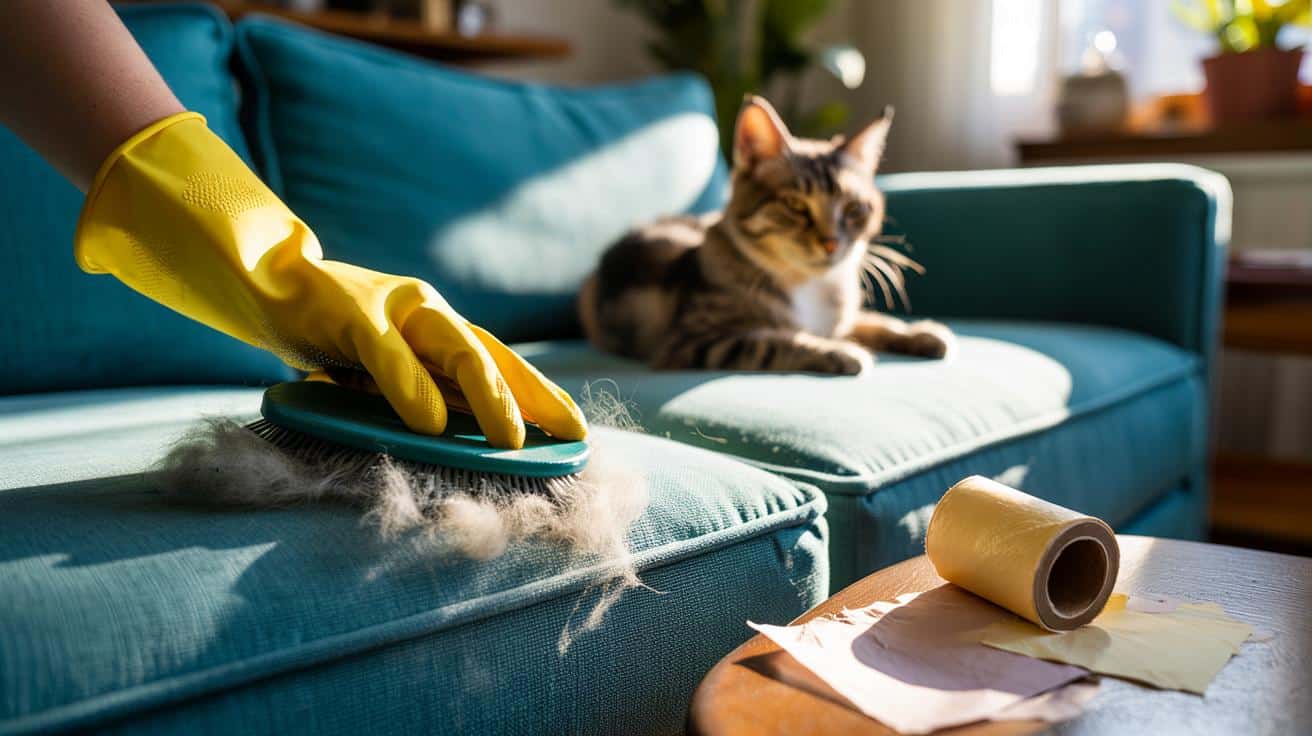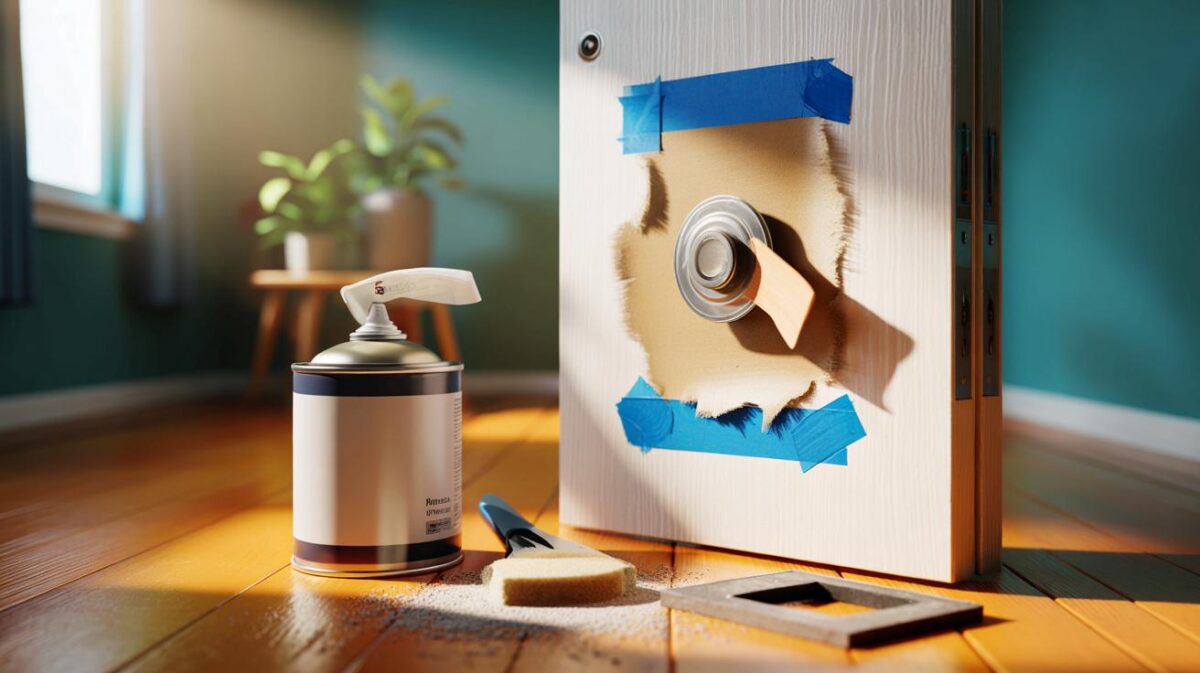It snags in the weave, laughs at sticky sheets, and reappears the minute you sit down. Lint rollers promise order, then run out mid-swipe, leaving a trail of wasted paper. Meanwhile, your cat blinks like a judge. There’s a simpler move doing the rounds in British living rooms, and it trades plastic for something already under your sink.
Saturday, 10am, that thin sun across the cushions. My tabby launches himself into a stretch and leaves a galaxy of fur behind. I pull a lint roller from the drawer, peel, swipe, peel, swipe. The stickiness dies fast. The stash of refills is gone. Across the landing, my neighbour waves a yellow washing-up glove, runs it over the armrest, and the hair piles up like tiny grey tumbleweeds. *It felt a bit like a magic trick.*
The day lint rollers lost the room
Lint rollers are brilliant for a quick outfit rescue on the way out. Sofas are a different beast. Their fibres grab and hold, and adhesives clog after a few passes. You burn through sheets, bin the cardboard core, and the fur still hides in the seams. It’s wasteful, pricey, repetitive. **There’s a point where the “easy fix” becomes more faff than fix.**
Ask any cat parent who hosts friends. One message in the group chat, and the roller comes out like a party trick. Three minutes later, you’re picking at a dull drum of sticky paper while the seat still looks fuzzy. At £3–£5 a roll, a household with two furry lodgers can churn through a small pile every month. The maths is boring. The frustration is not.
Here’s why it drags. Cat fur has tiny barbs that catch inside the fabric nap. Adhesive lifts the top layer, then gums up. Static plays a role too. Rubbing with rubber creates a mild charge that makes hair flock together. On certain fabrics, rubber bites just enough to gather strands without digging in. That’s the sweet spot lint rollers miss.
The simple trick: a damp rubber glove
Grab a basic washing-up glove. Lightly dampen the palm under the tap, then shake off the excess. Starting at the top of the cushion, sweep your hand in short, smooth strokes toward one edge. Hair clumps instantly. Scoop it into your other hand and bin it. Repeat. For corners and piping, use your knuckles like a tiny squeegee. **You don’t need another refill, just a glove and 30 seconds.**
A few notes from the sofa trenches. The glove should be damp, not wet. Too much water mats fibres and slows everything down. Go with the nap, then across it for the stubborn bits. On velvet or chenille, lighten the pressure and test an inconspicuous patch first. If the fabric is slick like leather or faux leather, switch to a dry microfiber cloth instead. Let’s be honest: nobody does that every day.
This move works because rubber builds light static and gentle friction, so hair travels in the same direction and clumps. No adhesives, no waste, no waiting for a delivery of refills. It’s fast enough to do before guests sit down, and kind to your upholstery when used with a soft touch.
“I used to keep a roller in every room,” says Amira, a pet-sitter who cleans between drop-ins. “Now I keep one glove by the sofa. It’s quicker, and I’m not peeling plastic like I’m gift-wrapping a problem.”
- Dampen, don’t soak: a quick pass under the tap is enough.
- Short strokes toward one edge, then lift the clump away.
- Use knuckles for seams and piping where fur gathers.
- For velvet, barely-there pressure keeps the pile smooth.
- No glove? A dry window squeegee or a rubber dog-grooming brush is a solid stand-in.
Less faff, more cuddles
We’ve all had that moment when guests are at the door and the sofa looks like a cardigan. The glove trick buys you calm. It’s quick by design and it scales: one cushion before work, the entire three-seater on a Sunday. Pair it with a weekly vacuum and a washable throw in winter. That’s a routine most of us can keep without turning the living room into a chore chart.
There are variations. A dry squeegee glides beautifully on tight-weave fabric. A slightly misted microfiber cloth shifts fine stragglers. On heavy, embedded fur, a spritz bottle with plain water can help reset static and bring hair to the surface. If allergies are in the mix, upgrade to a HEPA filter vacuum and wash the glove often. Small tweaks, big relief.
The real win is mental. Less peeling, less plastic, fewer little rolls rattling in drawers. You spend less, and you get back the soft lines of your sofa without a drama. **Your sofa, your rules.** Try the glove, share the results, and pass it on to the next cat person still wrestling a roll at 9pm.
| Key points | Detail | Reader benefit |
|---|---|---|
| Damp rubber glove sweep | Lightly wet glove, short strokes to one edge | Removes hair in seconds with zero waste |
| Squeegee or grooming brush backup | Dry window squeegee or rubber brush on tight weaves | Great for stubborn fur trapped deep in fibres |
| Gentle care for delicate fabrics | Test first, use minimal pressure on velvet/chenille | Clean sofa without crushing the pile or leaving marks |
FAQ :
- Will a rubber glove work on velvet or chenille?Yes, with a very light touch. Test a hidden spot, keep the glove barely damp, and sweep with the nap to protect the pile.
- Can I use nitrile or latex-free gloves?Absolutely. Nitrile or silicone washing-up gloves create the same light static and grip, and they’re great if you’re avoiding latex.
- What if I have leather or faux leather?Skip the damp glove. Use a dry microfiber cloth or a soft brush, then wipe with a slightly damp cloth for a clean finish.
- Does this reduce allergens or just hair?It mainly grabs hair. For dander and fine dust, add a weekly vacuum with a HEPA filter and launder throws at 60°C when the fabric allows.
- The hair is deeply embedded. Any pro tip?Lightly mist the sofa with plain water, wait 20 seconds, then glove in short strokes. For extreme cases, a dry squeegee followed by the glove lifts what’s left.









